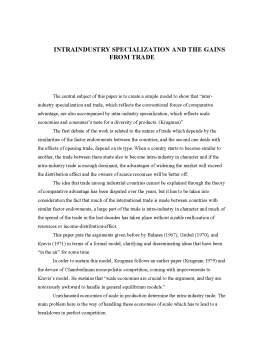Extras din referat
The central subject of this paper is to create a simple model to show that “inter-industry specialization and trade, which reflects the conventional forces of comparative advantage, are also accompanied by intra-industry specialization, which reflects scale economies and consumer’s taste for a diversity of products. (Krugman)”
The first debate of the work is related to the nature of trade which depends by the similarities of the factor endowments between the countries, and the second one deals with the effects of opening trade, depend on its type. When a country starts to become similar to another, the trade between them starts also to become intra-industry in character and if the intra-industry trade is enough dominant, the advantages of widening the market will exceed the distribution effect and the owners of scarce resources will be better off.
The idea that trade among industrial countries cannot be explained through the theory of comparative advantage has been disputed over the years, but it has to be taken into consideration the fact that much of the international trade is made between countries with similar factor endowments, a large part of the trade is intra-industry in character and much of the spread of the trade in the last decades has taken place without sizable reallocation of resources or income-distribution-effect.
This paper puts the arguments given before by Balassa (1967), Grubel (1970), and Kravis (1971) in terms of a formal model, clarifying and disseminating ideas that have been “in the air” for some time.
In order to sustain this model, Krugman follows an earlier paper (Krugman 1979) and the device of Chamberlinian monopolistic competition, coming with improvements to Kravis’s model. He sustains that “scale economies are crucial to the argument, and they are notoriously awkward to handle in general equilibrium models.”
Unexhausted economies of scale in production determine the intra-industry trade. The main problem here is the way of handling these economies of scale which has to lead to a breakdown in perfect competition.
Following Dixit and Stiglitz model, the author considers an industry with a larger number of companies, all producing differentiated products, all operating on the downward- sloping parts of their average cost curves. Because the companies in different countries produce differentiated goods and there are fixed costs in production, the international trade within the industry develops two-way and the economies of scale are the basic cause of intra-industry trade.
In the model of this paper, it is assumed that there are two groups of products and products from each group are closer substitutes than products in different groups, while factors of production are assumed to be mobile among products within each group yet immobile between groups.
Preview document
Conținut arhivă zip
- Intraindustry Specialization and the Gains from Trade.doc





